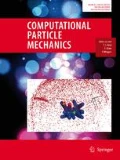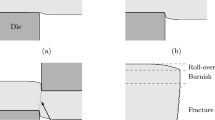Abstract
Flow drill screw (FDS) joining is a modern mechanical fastening technique for connecting metal parts in lightweight car structures. Finite element simulation of FDS joining probably is one of the biggest challenges for CAE engineers in automotive applications. This is mainly because finite element methods inevitably encounter utmost numerical difficulties associated with meshing issues in modeling the extensive plastic deformation and material failure taking place during the thread forming operation in the FDS driving process. This paper presents a FDS thread forming simulation using a new particle method based on authors’ recent work (Pan et al. in Comput Mech, 2019. https://doi.org/10.1007/s00466-019-01673-8). Different from other particle stabilization methods which are obtained by modification of the variational equation using either residual or non-residual stabilization terms, the present method introduces a novel velocity smoothing algorithm to achieve the stabilization effect. It is shown that the semi-discrete equation based on the smoothed velocity field is consistently fulfilling the conservation of linear and angular momentum. Since the new method does not require stabilization terms, it avoids the fundamental difficulty inherent in the stabilization stress computation, thus computationally more efficient. Finally, the stabilized formulation is supplemented with the adaptive anisotropic Lagrangian kernel and bond-based failure criterion to extend the application in severe deformation and material failure analysis. Three numerical benchmarks including one FDS thread forming simulation are utilized to demonstrate the effectiveness of the new approach.













Similar content being viewed by others
References
Sønstabø JK, Morin D, Langseth M (2016) Macroscopic modeling of flow-drill screw connections in thin-walled aluminum structures. Thin Wall Struct 105:185–206
Porcaro R, Hassen AG, Aalberg A, Langseth M (2010) Jointing of aluminum using self-piercing riveting: testing, modeling and analysis. Int J Crashworthiness 13:141–154
Wu CT, Bui TQ, Wu YC, Luo TL, Wang M, Liao CC, Chen PY, Lai YS (2018) Numerical and experimental validation of a particle Galerkin method for metal grinding simulation. Comput Mech 61:365–383
Wu CT, Wu YC, Crawford JE, Magallanes JM (2017) Three-dimensional concrete impact and penetration simulations using the smoothed particle Galerkin method. Int J Impact Eng 106:1–17
Grujicic M, Snipes J, Ramaswami S (2016) Process and product-performance modeling for mechanical fastening by flow drilling screws. Int J Struct Integr 7:370–396
Sønstabø JK, Morin D, Langseth M (2018) Static and dynamics testing and modeling of aluminum joints with flow-drill connections. Int J Impact Eng 115:58–75
Li S, Liu WK (2004) Meshfree particle method. Springer, Berlin
Belytschko T, Lu YY, Gu L (1994) Element-free Galerkin methods. Int J Numer Meth Eng 37:229–256
Liu WK, Jun S, Li S, Adee J, Belytschko T (1995) Reproducing kernel particle methods for structural dynamics. Int J Numer Methods Eng 38:1655–1679
Li B, Habbal F, Ortiz M (2010) Optimal transportation meshfree approximation schemes for fluid and plastic flows. Int J Numer Methods Eng 83:1541–1579
Chen JS, Pan C, Wu CT, Liu WK (1996) Reproducing kernel particle methods for large deformation analysis of non-linear structures. Comput Methods Appl Mech Eng 139:195–227
Wu CT, Park CK, Chen JS (2011) A generalized approximation for the meshfree analysis of solids. Int J Numer Methods Eng 85:693–722
Wang DD, Chen P (2014) Quasi-convex reproducing kernel meshfree method. Comput Mech 54:689–709
Chen JS, Wu CT, Yoon S, You YC (2001) A stabilized conforming nodal integration for Galerkin meshfree methods. Int J Numer Methods Eng 50:435–466
Hillman M, Chen JS, Chi SW (2014) Stabilized and variationally consistent nodal integration for meshfree modeling of impact problems. Comput Part Mech 1:245–256
Rabczuk T, Belytschko T, Xiao SP (2004) Stable particle methods based on Lagrangian kernels. Comput Methods Appl Mech Eng 193:1035–1063
Guan PC, Chen JS, Wu YC, Tang H, Gaidos J, Hofstetter K, Alsaleh M (2009) Semi-Lagrangian reproducing kernel formulation and application to modeling earth moving operations. Mech Mater 41:670–683
Wu CT, Koishi M, Hu W (2015) A displacement smoothing induced strain gradient stabilization for the meshfree Galerkin nodal integration method. Comput Mech 56:19–37
Wu CT, Chi SW, Koishi M, Wu YC (2016) Strain gradient stabilization with dual stress points for the meshfree nodal integration method in inelastic analysis. Int J Numer Methods Eng 107:3–30
Chen JS, Zhang X, Belytschko T (2015) An implicit gradient model by a reproducing kernel strain regularization in strain localization problems. Comput Methods Appl Mech Eng 193:2827–2844
Liu WK, Ong JS, Uras RA (1985) Finite element stabilization matrices: a unification approach. Comput Methods Appl Mech Eng 53:13–46
Hillman M, Chen JS (2016) An accelerated, convergent, and stable nodal integration in Galerkin meshfree methods for linear and nonlinear mechanics. Int J Numer Methods Eng 107:603–630
Wu CT, Wu YC, Liu Z, Wang D (2018) A stable and convergent Lagrangian particle method with multiple nodal stress points for large strain and material failure analyses in manufacturing processes. Finite Elem Anal Des 146:96–106
Belytschko T, Bindeman LP (1993) Assumed strain stabilization of the eight node hexahedral element. Comput Methods Appl Mech Eng 105:225–260
Pan X, Wu CT, Hu W, Wu YC (2019) A momentum-consistent stabilization algorithm for Lagrangian particle methods in the thermo-mechanical friction drilling analysis. Comput Mech. https://doi.org/10.1007/s00466-019-01673-8(in early view)
Wu CT, Koishi M (2012) Three-dimensional meshfree-enriched finite element formulation for micromechanical hyperelastic modeling of particulate rubber composites. Int J Numer Methods Eng 9:1137–1157
Beissel S, Belytschko T (1996) Nodal integration of the element-free Galerkin method. Comput Methods Appl Mech Eng 139:49–74
Onate E, Perazzo F, Miquel J (2001) A finite point method for elasticity problems. Comput Struct 79:2151–2163
Herreros MI, Mabssout M (2011) A two-steps time discretization scheme using the SPH method for shock wave propagation. Comput Methods Appl Mech Eng 200:1833–1845
Lee CH, Gil AJ, Greto G, Kulasegaram S, Bonet J (2016) A new Jameson–Schmidt–Turkel smoothed particle hydrodynamics algorithm for large strain explicit fast dynamics. Comput Methods Appl Mech Eng 311:71–111
Lee CH, Gil AJ, Hassan OI, Bonet J, Kulasegaram S (2017) A variationally consistent streamline upwind Petrov–Galerkin smoothed particle hydrodynamics algorithm for large strain solid dynamics. Comput Methods Appl Mech Eng 318:514–536
Liu GR, Liu MB (2003) Smoothed particle hydrodynamics. World Scientific, Singapore
Silling SA, Askari E (2005) A meshfree method based on the peridynamic model of solid mechanics. Comput Struct 83:1526–1535
Ren B, Wu CT, Askari E (2017) A 3D discontinuous Galerkin finite element method with the bond-based peridynamics model for dynamics brittle failure analysis. Int J Impact Eng 99:14–25
Hallquist JO (2006) LS-DYNA® keyword user’s manual. Livermore Software Technology Corporation, Livermore
Wilkins ML, Guinan MW (1973) Impact of cylinders on a rigid boundary. J Appl Phys 44:1200–1206
Johnson GR, Cook WH (1983) A constitutive model and data for metals subjected to large strains, high strain rates, and high temperatures. In: Proceedings 7th international symposium on ballistics pp 541–547; The Hague, Netherlands, 19–21 April 1983
Schwer LE (2009) Aluminum plate perforation: a comparative case study using Lagrange with erosion, multi-material ALE, and smooth particle hydrodynamics. In: 7th European LS-DYNA conference, Salzburg, Austria, 14–15 May 2009
Skovron J, Mears L, Ulutan D, Detwiler D, Paolini D, Baeumler B, Claus L (2015) Characterization of flow drill screwdriving process parameters on joint quality. SAE Int J Mater Manf 8:35–44
Acknowledgements
The authors wish to thank Dr. John O. Hallquist of LSTC for his support to this research. The support from Ford Motor Company is also gratefully acknowledged.
Author information
Authors and Affiliations
Corresponding author
Additional information
Publisher's Note
Springer Nature remains neutral with regard to jurisdictional claims in published maps and institutional affiliations.
Rights and permissions
About this article
Cite this article
Wu, C.T., Wu, Y., Lyu, D. et al. The momentum-consistent smoothed particle Galerkin (MC-SPG) method for simulating the extreme thread forming in the flow drill screw-driving process. Comp. Part. Mech. 7, 177–191 (2020). https://doi.org/10.1007/s40571-019-00235-2
Received:
Revised:
Accepted:
Published:
Issue Date:
DOI: https://doi.org/10.1007/s40571-019-00235-2




